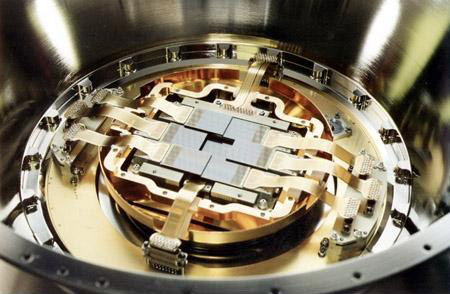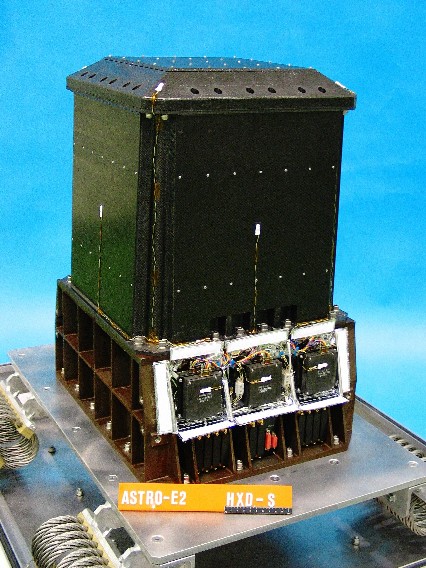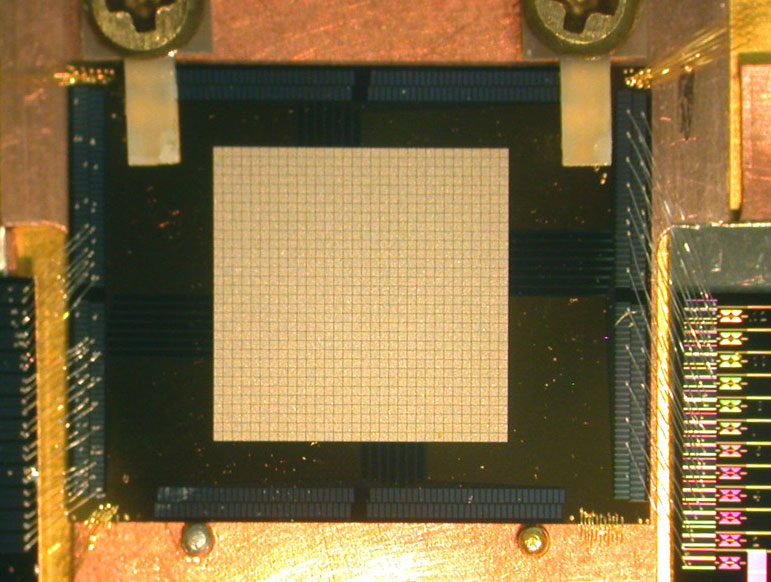X-ray Detectors - More Information

Photo of the European Photon Imaging Camera (EPIC) CCD array on XMM-Newton. (Credit: Leicester University, University of Birmingham, CEA Service d'Astrophysique Saclay and ESA)

Photo of the Hard X-ray Detector before it was installed on the Suzaku satellite. (Credit: JAXA/ISAS and NASA)

Photo of a 32 by 32 microcalorimeter array. (Credit: NASA/Goddard Space Flight Center)
The quest of X-ray astronomy is to be able to detect a weak source against a fairly strong background. X-ray sources are detected on a photon-by-photon basis. In X-ray astronomy, a source that gives just one photon per centimeter per second (in the 1-10 keV range) at Earth is considered a bright cosmic X-ray source. The relative weakness of X-ray sources has prevented detectors such as film from finding a place in cosmic X-ray astronomy.
How do we measure the energy (or wavelength) of an X-ray photon? We need the X-ray to give all its energy to a detector. That energy will change something in the detector and, by measuring the change, we can determine the energy of the incoming X-ray.
X-rays interact strongly with electrons. If you've ever had a medical or dental X-ray, you were probably given a lead drape to protect you from the X-rays. Lead is very good at blocking X-rays because each lead atom has 82 electrons and the atoms of lead are packed pretty close. Lead stops X-rays because it has a large electron density.
When an X-ray interacts with matter, it can can give all of its energy to an electron (a process called photo-electric absorption), or it can give some of its energy (a process called Compton scattering), or it can scatter without losing any energy (a process called Rayleigh scattering). The probability associated with each of these kinds of scattering depends on the energy of the X-ray photon, the bound state the electron is in, and the scattering angle. For the energies of most interest to X-ray astronomy, photo-electric absorption is much more likely than the other two kinds of scattering.
Typically when an X-ray stops in a detector, it has given all of its energy to one electron. That electron can rattle around in the detector and give energy to other electrons. In some materials, these electrons will have enough energy to be freed of their host atoms. In that case, applying an electric field will allow those free electrons to be collected and counted. The number of electrons collected tells you the energy that was deposited.
Tell me more about detectors that use electrical current to characterize incoming X-rays
In some materials, the energy of the incoming X-rays is converted into visible light. This process is called "scintillation." The resulting light can then be detected with a photomultiplier tube.
Tell me more about detectors that use scintillation to characterize incoming X-rays
Another approach to X-ray detection is measuring the heat it deposits in a material. All those excited electrons would rather go back to their original energy, returning to what is called the "ground state." They can lose that extra energy through scattering with other electrons or with vibrations in the solid itself. That energy heats the solid, increasing its temperature, and the temperature change gives a measure of the energy of the incoming X-ray.
Tell me more about detectors that use heat to characterize incoming X-rays
No matter which observational technique is used to view the X-ray sky, the final outcome of a measurement is determined by the properties of the electronic detector with which the collimated, focused, or diffracted X-ray photons eventually interact.
Text updated: September 2018


